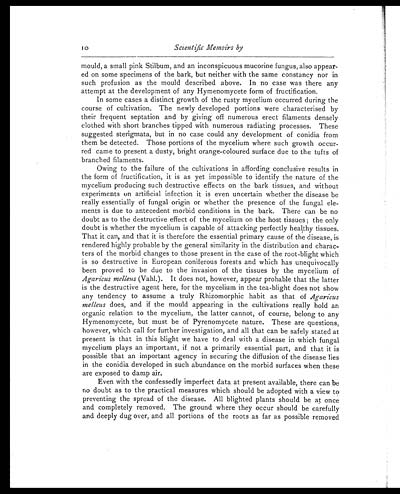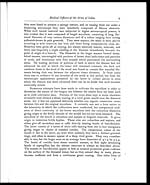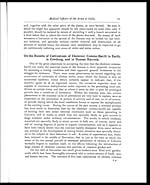Medicine - Institutions > Army health reports and medical documents > Scientific memoirs by medical officers of the Army of India > Part III, 1887 > 1 - Notes from the biological laboratory attached to the Office of the Sanitary Commissioner with the Government of India
(16) Page 10
Download files
Individual page:
Thumbnail gallery: Grid view | List view

10
Scientific Memoirs by
mould, a small pink Stilbum, and an inconspicuous mucorine fungus, also appear-
ed on some specimens of the bark, but neither with the same constancy nor in
such profusion as the mould described above. In no case was there any
attempt at the development of any Hymenomycete form of fructification.
In some cases a distinct growth of the rusty mycelium occurred during the
course of cultivation. The newly developed portions were characterised by
their frequent septation and by giving off numerous erect filaments densely
clothed with short branches tipped with numerous radiating processes. These
suggested sterigmata, but in no case could any development of conidia from
them be detected. Those portions of the mycelium where such growth occur-
red came to present a dusty, bright orange-coloured surface due to the tufts of
branched filaments.
Owing to the failure of the cultivations in affording conclusive results in
the form of fructification, it is as yet impossible to identify the nature of the
mycelium producing such destructive effects on the bark tissues, and without
experiments on artificial infection it is even uncertain whether the disease be
really essentially of fungal origin or whether the presence of the fungal ele-
ments is due to antecedent morbid conditions in the bark. There can be no
doubt as to the destructive effect of the mycelium on the host tissues; the only
doubt is whether the mycelium is capable of attacking perfectly healthy tissues.
That it can, and that it is therefore the essential primary cause of the disease, is
rendered highly probable by the general similarity in the distribution and charac-
ters of the morbid changes to those present in the case of the root-blight which
is so destructive in European coniferous forests and which has unequivocally
been proved to be due to the invasion of the tissues by the mycelium of
Agaricus melleus (Vahl.). It does not, however, appear probable that the latter
is the destructive agent here, for the mycelium in the tea-blight does not show
any tendency to assume a truly Rhizomorphic habit as that of Agaricus
melleus does, and if the mould appearing in the cultivations really hold an
organic relation to the mycelium, the latter cannot, of course, belong to any
Hymenomycete, but must be of Pyrenomycete nature. These are questions,
however, which call for further investigation, and all that can be safely stated at
present is that in this blight we have to deal with a disease in which fungal
mycelium plays an important, if not a primarily essential part, and that it is
possible that an important agency in securing the diffusion of the disease lies
in the conidia developed in such abundance on the morbid surfaces when these
are exposed to damp air.
Even with the confessedly imperfect data at present available, there can be
no doubt as to the practical measures which should be adopted with a view to
preventing the spread of the disease. All blighted plants should be at once
and completely removed. The ground where they occur should be carefully
and deeply dug over, and all portions of the roots as far as possible removed
Set display mode to: Large image | Zoom image | Transcription
Images and transcriptions on this page, including medium image downloads, may be used under the Creative Commons Attribution 4.0 International Licence unless otherwise stated. ![]()
| Permanent URL | https://digital.nls.uk/75004048 |
|---|
| Shelfmark | IP/QB.10 |
|---|---|
| Additional NLS resources: | |




